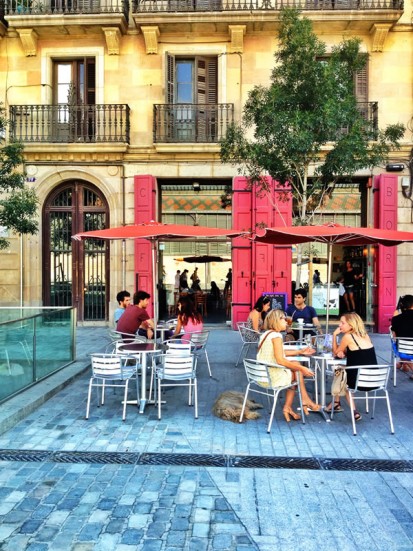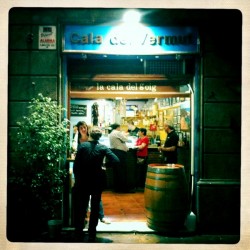
Selecció d’olives i conserves Gloria, Mercat de l’Abaceria
I kindly received an invite from Devour Barcelona food tours to join them one morning. A food tour in Gràcia, one of my favourite neighbourhoods in Barcelona, sounded like great fun. So one Friday morning I found myself at the top of Passeig de Gràcia with our guide, the lovely Renée, giving us a brief history of the street and its connection to the neighbourhood of Gràcia.
And then off we went. Four hours of walking, talking, grazing, learning and generally passing the morning in a thoroughly pleasant way.
This was a food tour that was about more than just the food. Renée knew her stuff. And we were taken on a tour of not only the food, but of the people who prepare and serve it and the neighbourhood that they call home. It is a cultural walking tour that focuses on real lives with the added benefit that these people’s lives are about their passion for food. Read the rest of this article…

The terrace at Cafè del Born Nou, Plaça Comercial, 10
Choosing a neighborhood in Barcelona wasn’t easy at first. I was moving on after years of living in Madrid, what many call the most genuine Spanish city out there, and I had been warned that my experience in Barcelona might not be the same in that aspect. People told me that its authenticity wouldn’t be as palpable, and that I might have a hard time truly immersing myself into the culture. And this was something important for me.
After much debate and seeing at least thirty different apartments, it so happened that the one I fell in love with was in the Born. This had its pros and cons… the Born is a beautiful neighborhood with an awesome location, it’s lively and bustling yet safe and pleasant… but on the other hand, after the very diverse Raval, the Born is arguably the least “Catalan” neighborhood in the city. Having undergone a recent gentrification, the once seedy neighborhood has become one of the trendiest around, and its population has evolved into a cosmopolitan melting pot of bohemian expats, replanted immigrants, wandering tourists and the like. Read the rest of this article…
So what is vermouth?
“Vermouth (pronounced ‘ver-məθ [UK] or /vərˈmuːθ/ [US]) is a fortified wine flavored with various dry ingredients. The word “vermouth” comes from the German word wermut for wormwood that has been used as an ingredient in the drink over its history. The modern versions of the beverage were first produced around the late 18th and early 19th centuries in Italy and France. Vermouth was consumed as a medicinal libation until the latter 19th century when it became an important ingredient in many of the first, classic cocktails, such as the martini.” Wikipedia

Cala del Vermut, c/ Magdalenes, 6
Now my knowledge of vermouth is limited to say the least. I always associated it with the Italian red vermouth, Martini Rosso. A foul drink as I remember. A drink from a different era. A drink my parents drunk at dinner parties. I’d tasted it, but generally it was to be avoided. Maybe in the odd cocktail, but on its own, no thank you.
And then I moved to Barcelona and was taken to my very first ‘vermut’ bar, Cala del Vermut, where they serve their own label, Catalan brewed, Spanish vermouth on tap. It comes in a tall straight glass, with ice and a green olive. It was fantastic. I loved it. The perfect apéritif. And at €2 it is an absolute bargain. Read the rest of this article…








